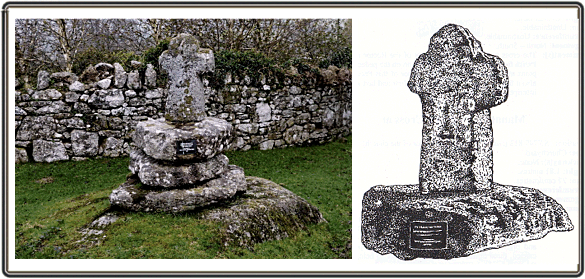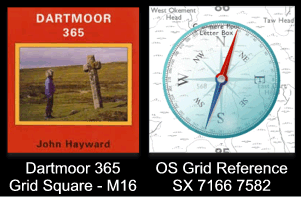
Dunstone Cross – I don’t know why but this little granite cross perched serenely on its high granite pedestals is one of my favourite of the Dartmoor crosses. So much so that the cross appears on both the front and back cover of my book – ‘A Pilgrimage to Dartmoor’s Crosses.’ I have only just realised that I had not dedicated a page to it, so here we are.
Dunstone Cross or Lower Dunstone Cross sits on the small village green at the little hamlet of Dunstone which is just outside Widecombe-in-the-Moor. Dunstone is one of the old manors of Widecombe and is listed in the Domesday Book. Bill Harrison suggests that the cross was possibly a preaching cross which then became a village cross and was erected by one of the Lords of the manor of Dunstone. p.176. Not only would local folk gathered at the cross for services but it is known that Manor Courts were held at ‘the’ actual Dunstone which sits just adjacent to the cross.
Like many of the Dartmoor crosses this one has also known several homes. Sometime between 1815 and 1860 the vicar of Widecombe the Reverend J. H. Mason decided for reasons better known to himself to remove the cross to the vicarage garden. William Crossing wrote; “It is now fixed at the end of a low wall, and over the lower portion of the shaft some ivy has spread itself, as if to shelter the grey old relic from the rude blasts of the neighbouring hills.” pp. 164-5. It is a sad fact that many of Dartmoor’s ‘relics’ have suffered such a fate where for reasons of ‘preservation’ they have been removed from their original locations and deposited in places of so-called safety. Again on this matter Crossing quite aptly wrote; “While it is pleasing to find this ancient cross (Dunstone) has been preserved, it is at the same time much to be regretted that it was considered necessary to remove it from its original site, and to erect it in a private garden, where none can see it except as a favour.” p.164, fn.

In 1980 salvation and repatriation was at had for the little cross when the Rev. M. Brown gave permission for it to be removed from the garden and replaced on the green. The then lady of the manor, Miss M. Hamlyn, was instrumental in providing funding for the project. Accordingly a memorial plaque was placed on the top of the three boulders which reads; “Dunstone cross back in its original site after – 100 years in the Vicarage garden – Restored by Miss M. Hamlyn, Dunstone Manor, 1980.”
The dimensions of Dunstone Cross are that is stands to a height of 93 centimetres and has an arm span of 58 centimetres with a shaft circumference of 1.07 metres. There is a small incised cross measuring some 25 by 12.5 by Centimetres metres located on the front lower portion of the shaft’s west face. Sandles, p.60.
Dunstone cross sits on Dunstone Green,
Upon three boulders it can be seen.
Where long ago monks would preach,
Their gospel message they would teach.
Centuries later for reason unknown
The ancient cross was overthrown.
To the vicarage garden it was sent
For safe keeping supposedly meant.
In ninety eighty one its restoration came,
Thanks to a benefactor, Lady Hamlyn by name.
Once again it was taken back home
To sit upon a mighty granite throne.

Crossing, W. 1987. The Ancient Stone Crosses of Dartmoor. Exeter: Devon Books.
Harrison, B. 2001. Dartmoor Stone Crosses. Tiverton: Halsgrove Publishing.
Sandles, T. 1997. A Pilgrimage to Dartmoor’s Crosses. Liverton: Forest Publishing.
Starkey, F. H. 1983. Dartmoor Crosses. Callington: F. H. Starkey.

“On the third of three boulders on the green stands Dunstone Cross. The plaque beneath it tells part of its history. It appears that the cross fell down about the middle of the last century, and was ‘rescued’ by the vicar of Widecombe and set up in the vicarage garden.” J. Hayward, Dartmoor 365, p.234.
 Legendary Dartmoor The many aspects past and present of Dartmoor
Legendary Dartmoor The many aspects past and present of Dartmoor

Just made friends with a Paul Dunstone, born and living in Melbourne. He knows his forebears originated from Devon but little else. His present question is whether his surname (and of course the village name) is pronounced Dun Stone ( as in a rock) or Dun Stun (as in being knocked out). Can you help with the correct pronunciation of the village please? I suspect the former, since, as pointed out in your website, the etymology is from brown rock. Thank you for your time
Difficult to say as it depends on ones regional accent, locally I would say ‘Dunston’ without pronouncing the ‘e’